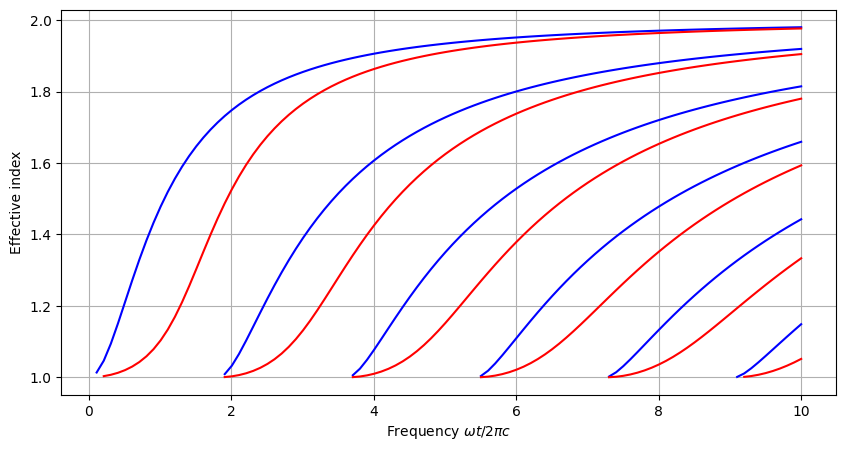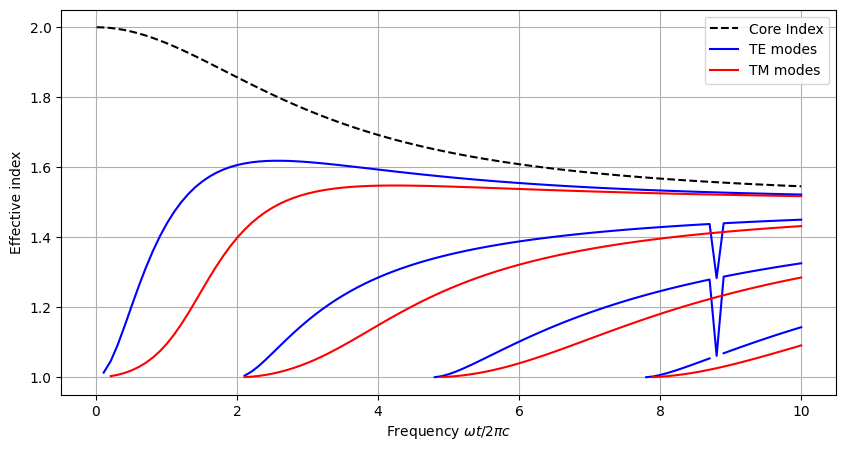Frequency sweep and dispersive materials#
This example show how to make frequency sweeps and hot to treat dispersive materials in a simulation.
Import packages#
import numpy as np
import matplotlib.pyplot as plt
import remsol
from remsol import Polarization as pol
Frequency sweep#
Structure definition#
Structure definition is the same as in the previous example.
# Define the layers
layers = [
remsol.Layer(n=1.0, d=1.0),
remsol.Layer(n=2.0, d=1.0),
remsol.Layer(n=1.0, d=1.0),
]
# Define the multilayer
multilayer = remsol.MultiLayer(layers)
Wrapper function definition#
Instead of calling multilayer.neff directly, we will define a wrapper function which catches the exception and returns np.nan in case the mode is not found.
def neff_wrapper(omega: float, polarization: pol, mode: int):
try:
return multilayer.neff(omega, polarization, mode)
except Exception as e:
return np.nan
omegas = np.linspace(0.01, 10, 101)
fig, ax = plt.subplots(1,1, figsize=(10, 5))
for mode in range(8):
neffs = [neff_wrapper(om, pol.TE, mode) for om in omegas]
ax.plot(omegas, neffs, 'b-')
neffs = [neff_wrapper(om, pol.TM, mode) for om in omegas]
ax.plot(omegas, neffs, 'r-')
ax.set_xlabel('Frequency $\omega t/2 \pi c$')
ax.set_ylabel('Effective index')
ax.grid()
<>:8: SyntaxWarning: invalid escape sequence '\o'
<>:8: SyntaxWarning: invalid escape sequence '\o'
/tmp/ipykernel_2995/2849425473.py:8: SyntaxWarning: invalid escape sequence '\o'
ax.set_xlabel('Frequency $\omega t/2 \pi c$')

Dispersive materials#
The module has no built-in support for dispersive materials, but it is possible to define the structure as a function of frequency and call the solver for each frequency.
Wrapper function defiition#
It is still important for the wrapper function to handle the mode not found exception.
def n_function(omega: float):
return 2.0 -0.5 * omega**2 / (10.0+omega**2)
def calculate_neff(omega: float, polarization: pol, mode: int):
layers = [
remsol.Layer(n=1.0, d=1.0),
remsol.Layer(n=n_function(omega=omega), d=1.0),
remsol.Layer(n=1.0, d=1.0),
]
multilayer = remsol.MultiLayer(layers)
try:
return multilayer.neff(omega, polarization, mode)
except Exception as e:
return np.nan
omegas = np.linspace(0.01, 10, 101)
fig, ax = plt.subplots(1, 1, figsize=(10, 5))
for mode in range(8):
neffs = [calculate_neff(om, pol.TE, mode) for om in omegas]
te_plot=ax.plot(omegas, neffs, "b-")
neffs = [calculate_neff(om, pol.TM, mode) for om in omegas]
tm_plot=ax.plot(omegas, neffs, "r-")
core_plot = ax.plot(omegas, [n_function(omega=om) for om in omegas], "k--")
ax.legend([core_plot[0], te_plot[0], tm_plot[0]], ["Core Index", "TE modes", "TM modes"], loc="upper right")
ax.set_xlabel("Frequency $\omega t/2 \pi c$")
ax.set_ylabel("Effective index")
ax.grid()
<>:28: SyntaxWarning: invalid escape sequence '\o'
<>:28: SyntaxWarning: invalid escape sequence '\o'
/tmp/ipykernel_2995/1852355976.py:28: SyntaxWarning: invalid escape sequence '\o'
ax.set_xlabel("Frequency $\omega t/2 \pi c$")

